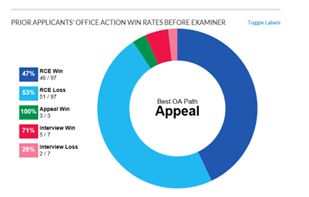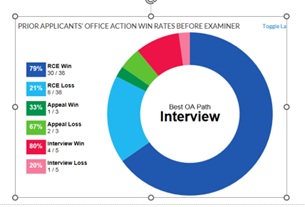
US Patent Practice: Minimizing the Need for RCE Filings
Typical Prosecution Flow
The typical flow of prosecution before the U.S. Patent Office begins when the U.S. Examiner issues a First Official Action on the merits. A response is then submitted to the First Official Action and the U.S. Examiner considers this response. If the application is not allowed, the Examiner issues a Second Official Action, which is almost always a Final Official Action.
Once a final rejection has been issued, the Applicant’s options are limited. Substantive amendments are rarely allowed by the Examiner after a final rejection.
Before Filing a Response
The first step is to check to make sure that the rejection has been properly made final. Although not often, sometimes the Examiner makes a rejection final when it should not be final. For example, if the Examiner needs to rely on new prior art in the second rejection, and the need for the new prior art was not caused by amendments made in response to the first rejection, the second rejection should not be made final.
Responses After a Final Office Action
There are several options to consider when responding to a Final Office Action. The options include:
(1) Filing an amendment or request for reconsideration. Neither of these options are usually successful.
(2) Filing an After Final Consideration Pilot Program 2.0 (AFCP2.0) response. The AFCP2.0 response requires a narrowing amendment, and is frequently not entered. However, it usually results in a productive interview with the Examiner which can help determine a proper course of action.
(3) Filing a Request for Continued Examination (RCE). This option requires a USPTO fee of $1360 PTO for a first RCE, and a $2000 USPTO fee for each RCE filed after a first RCE.
(4) Filing a Notice of Appeal. This option requires a USPTO fee of $840 PTO fee.
An Applicant can also file some combination of these.
Timing is important to keep in mind. Options (1) and (2) above do not reset the period for response. The clock keeps running. Accordingly, one must be careful to avoid abandonment.
Avoid the RCE Loop
Examiners receive “counts” when an RCE is filed. The counts are how the USPTO measures the productivity of an Examiner. Accordingly, it is important to Examiners to generate as many counts as possible. Since Examiners receive “counts” when an RCE is filed, many Examiners try to encourage the filing of RCEs.
However, after an Applicant files an RCE with additional claim amendments, some Examiners routinely simply issue a new rejection and add another reference to the rejection that teaches the new feature added by the claim amendment. Frequently, there is no justifiable motivation for adding the new reference to the other references previously applied. This is sometimes referred to as an RCE loop, because it can repeat for several cycles, causing the Applicant to spend much money in USPTO fees.
Use of Dependent Claims
The appropriate use of dependent claims is one way to avoid the issuance of a final rejection. When filing the application, or filing a response to a first, nonfinal rejection, it is helpful to include a range of dependent claims, including some relatively narrow, detailed claims.
Examiners frequently don’t pay attention to the dependent claims and may improperly reject a narrow claim for the same reason as the independent claim. When responding to the First Office Action, consider putting such a narrow dependent claim into independent form without any changes to the claim scope. If the Examiner rejects the claim again, but under different grounds, he/she cannot make the rejection final per MPEP § 706.07(a).
Second or any subsequent actions on the merits shall be final, except where the examiner introduces a new ground of rejection that is neither necessitated by applicant’s amendment of the claims, nor based on information submitted in an information disclosure statement filed during the period set forth in 37 CFR 1.97(c) with the fee set forth in 37 CFR 1.17(p).
Interview Examiner after First Office Action
Interviewing the Examiner after the First Office Action is a cost-effective way to avoid a final Office Action. Many times, during the interview, the Applicant can reach an agreement with the Examiner on how to put the application in condition for allowance.
If an agreement with the Examiner cannot be reached after the first Office Action, file a response with claims that (1) Applicant believes distinguish over the applied art, and (2) include a scope that the Applicant is willing to accept.
Notice of Appeal
An often overlooked course of action is to file a Notice of Appeal in response to a final Office Action. The Notice of Appeal can be filed by itself, or with a Pre-Appeal Brief Review Request (PABR).
If a Pre-Appeal Brief Review Request (PABR) is to be used, it must be filed with the Notice of Appeal. If the PABR is not successful, an appeal brief can then be filed.
A PABR is only appropriate if there is a clear factual or legal error in the rejection (objective criteria), such as failure to identify a claimed element in the prior art or failure to explain how a reference meets the recitations of the claim. A PABR is not appropriate to argue interpretation of reference and/or claims, or to argue obviousness (subjective issues).
If the Pre-Appeal Brief Request is not successful, the Applicant can file an RCE and further amend the claims, or file an Appeal Brief and continue with appeal.
However, Examiners do not like preparing an Examiner’s Answer, which an Examiner must do after the Applicant files an Appeal Brief. As an alternative, the Examiner has the authority to allow an application or reopen prosecution after a Notice of Appeal and an appeal brief is filed.
In a survey of a recent 10-year period for one client, an Appeal Brief was filed in 19 cases. The results were very interesting:
- 11 rejections were withdrawn after the filing of the Appeal Brief;
- 2 express abandonments were filed before a decision was issued on the Appeal;
- In 5 cases, the Examiner was affirmed;
- In 1 case, we received a decision reversing Examiner.
Accordingly, in 12 out of 17 appeals, the Applicant received positive results. In other words, in ~ 70% of the cases, the Applicant prevailed.
Strategy
These results suggest that serious consideration should be given to filing a Notice of Appeal ($840) and an Appeal Brief versus a Request for Continued Examination ($1360/$2000).
The strategy can be changed at any time. After receiving the Examiner’s answer, it is possible to withdraw the appeal and file an RCE without having to pay the appeal forwarding fee. This might be appropriate if the examiner provides a new explanation of the rejection that can be better addressed by an amendment.
When considering strategy, rely on past experience with the Examiner. Questions to think about based on prior experience with the Examiner include:
(1) Does the always just add new references every time you add a new claim element? and
(2) Is the Examiner willing to work with the attorney?
If the Applicant’s attorney does not have much experience with the Examiner, research tools, such as Juristat reports, can be quite useful. For example, reviewing publicly available data, one would conclude that when working with the Examiner whose data is on the left, the best option would be to appeal. However, when working with the other Examiner, it would be better to conduct an interview and file an RCE.


Interesting data was prepared by a company called Juristat several years ago. As can be seen in the following charts, when responding to a § 103 obviousness final rejection, most Applicants (56.6%) chose to file an RCE. However, as shown from the chart below on the right, filing an Appeal was successful much more often than the RCE route.

Takeaways: Responding to Final Rejections
Each application is different -- the claims are different, the rejections are different, the prior art is different, the prosecution history is different, and the issues are different. There is no single approach that should be used to respond to all applications to avoid an RCE. Do not always take the same approach when responding to Official Actions.
To reduce the need for filing an RCE do not wait until responding to the Final Official Action. For example, take certain actions earlier in an application, before the issuance of a final Official Action. Specifically, when responding to the first Official Action, consider approaches that might help reduce the need for an RCE. Such approaches include interviewing the Examiner after the first Office Action, and/or using a broad range of claims so that some claims may be found to be allowable, even if the broad independent claims are not allowable.


